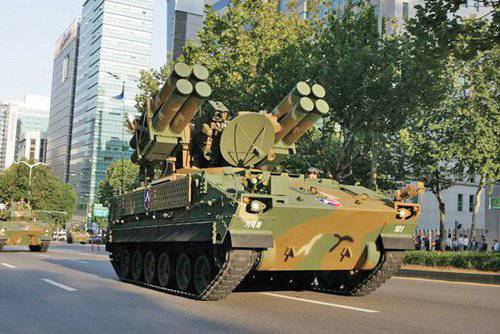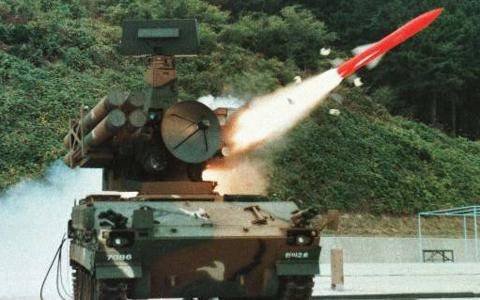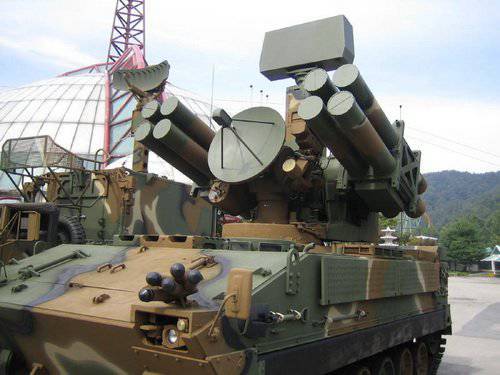ZRK Crotale-NG / Chun Ma
The latest version of the complex is Crotale-NG (New Generation). The main task of this air defense complex is to cover tank units on the march, as well as the implementation of zonal and object air defense. Serial production of Crotale-NG was started in 1990. Almost immediately 20 tracked air defense systems based on the Sisu XA-180 were acquired by Finland, 12 stationary-based systems were purchased by the French Air Force and Navy (container-type air transportable firing assemblies), another 11 complexes were bought by Greece (9 for the ground forces and 2 for the Navy) ...
The new version of the Crotale complex uses the high-speed rocket VT-1, created jointly by the French company Thomson-CSF and the American LTV. The missile was developed for the American army under the program "Faad". According to the manufacturers, the Crotale-NG air defense system was a response to the emergence of new aviation equipment, which allows aircraft to make air strikes at any time of day and in any weather, and attack helicopters to use the possibility of flying around the terrain.

The VT-1 rocket (Vought-Thomson) was developed from the 1986 of the year and went into production in the 1990 year. The rocket has a radio command / electron-optical targeting system. The maximum range of the missile is 10 km, the maximum speed is Mach 3,5, and the rocket also has high maneuverability and withstands overloads in 35 g. All this allows the rocket to effectively hit maneuvering air targets at a distance of 8 km in approximately 10 seconds.
The VT-1 anti-aircraft missile (missile defense) consists of a warhead, in which a contact fuse and a proximity fuse, guidance system equipment, a battery, electronic data processing equipment, a 14 fragmentation warhead with a mass of 0,2 kg can be used. The warhead of the rocket contains pre-fragmented debris, which, when undermined, target the air target and are quite effective against small targets. The electromagnetic fuse fires in the 0,5-8 range of seconds to the point where the rocket meets the target. The radius of destruction of the warhead fragments is about XNUMX meters. In the central compartment of the rocket there is a solid fuel engine with a powder charge, in which special low-smoke fuel is used. In the tail section there is a folding stabilizer, a transceiver and a control unit (gas, high pressure).
ZRK Chun Ma
At the beginning of the 90-ies, South Korea purchased several Crotale-NG air defense missile systems with the aim of their further modernization. As a result, the Korean air defense complex “Pegasus”, the Korean name Chun Ma, was born. Currently, the Army of South Korea is not less than 114 of such complexes.
Production of individual units of the Chun Ma air defense complex was launched by South Korea in 1996. The main executor of the project was a special division of the well-known South Korean corporation Daewoo. The developed complex was created to protect the mechanized units of the South Korean army on the march and on the battlefield. As a platform, a tracked chassis was chosen, which is the latest version of a number of samples designed by the corporation for the South Korean army. The new all-wheel drive K200A1 chassis, taken as the basis for the Chun Ma complex, is longer compared to previous versions, including the chassis that houses the 30-mm anti-aircraft coaxial Flying Tiger artillery.

The first prototypes of the complex were ready in 1996 year, at the same time the military began to test it. The chassis of the Chun Ma air defense system is armored to protect the crew from small arms fire. weapons and shell fragments. The driver is located in front of the left side. Also in front on the right side is the 10-cylinder diesel engine D2840L with a power of 520 hp, which is paired with an automatic gearbox. Engine power allows the complex to reach speeds of 60 km / h. From a spot to 32 km / h, the car accelerates in 10 seconds. The run without refueling is 500 km, while the AMS is able to overcome the rises in 60%.
The total weight of the complex with weapons, according to experts, is 25 tons. At the same time, an 43-strong engine is additionally installed on the chassis, as well as a set of equipment, including a machine shelling warning system, a filter-ventilation unit, and a smoke jamming system.
On top of the chassis K200A1 mounted equipment starting complex, which consists of 8 transport and launch containers with missiles (4 on each side). In the central part there is a pulse / Doppler observation radar of the E / F range, which is able to detect targets at a distance of 20 km. Complex survey radar is able to detect and track up to 8 targets simultaneously. Below the survey radar, a pulse-Doppler radar tracking station operating in the Ku-wavelength range is installed. The range of its action is equal to 16 km. This radar is used for tracking air targets, the maximum speed of which does not exceed Mach 2.
The control commands are transmitted aboard the rocket by radio beam. Both radar stations can instantly tune the frequency from pulse to pulse. On the left side of the target tracking radar, a special FLIR (Forward Looking Infra-Red) thermal imaging system is installed, the range of which is 15 km. To the right of the radar there is a TV camera with an IR goniometer with a target detection range of up to 10 km. The infrared goniometer is used for the initial detection and capture of a launched missile, its viewing sector is 10 degrees.
The rocket used in the Chun Ma complex was developed by the South Korean consortium independently, therefore it differs from French-made rockets. Solid propellant missiles are made according to the normal aerodynamic configuration. The rocket has a 4 steering wheel in the middle of the hull and a 4 steering wheel in the tail section. The maximum rocket speed can be Mach 2,6. The maximum effective range of target destruction is 10 km with the possibility of making a maneuver with an overload to 30g at the farthest point of the affected area. Warhead missile high-explosive fragmentation, directional. The warhead can be equipped with both contact and non-contact laser fuse and provides a high probability of destruction of enemy air assets.

When spending all 8 missiles reloading is carried out by the crew of the air defense system in manual mode. The missile guidance operator has a multi-screen panel in front of it consisting of color monitors. The software and computing tools used in this air defense system allow it to be integrated into any air defense system.
According to Daewoo Corporation, the Chun Ma complex can destroy targets at any time of the day, as well as in a difficult jamming environment. The equipment of the launch complex and the means for detecting targets are identical to those used in the French version of the air defense missile system and are supplied by Thomson-CSF Airsys. ”
TTH ZRK Chun Ma
Target detection range - 20 km.
The number of accompanied targets - 8 units.
The maximum damage range is 10 km, the minimum one is 0,5 km.
The height of destruction of targets is maximum - 6 km, the minimum - 0,02 km.
Complex recharge time - 10 min.
Rocket length - 2,29 m.
Rocket diameter - 0,16 m.
Missile weight - 75 kg.
Mass of warhead - 14 kg.
Type of high-explosive fragmentation warhead with contact or non-contact fuses
Maximum rocket speed - 2,6M
Maximum allowable overload - 30g
Radio command missile guidance method
Information